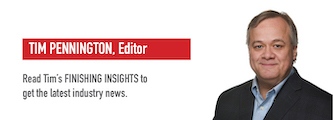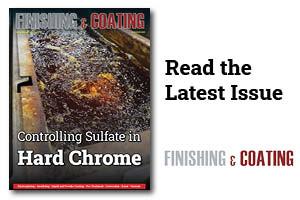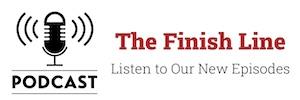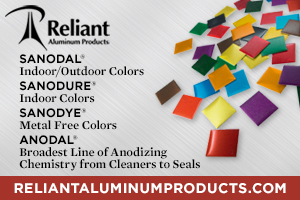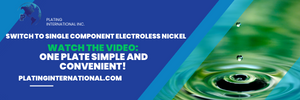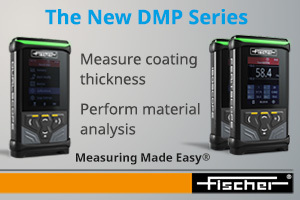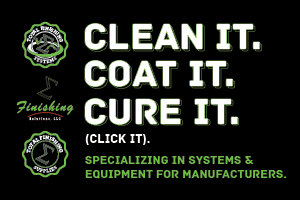R.J. Thomas Manufacturing has never skimped on furnishing its fabrication facility with top-of-the-line equipment for its employees.
 Adam ThomasThe Cherokee, Iowa, manufacturer of Pilot Rock park equipment that was founded in 1959 always has the latest welding and cutting equipment for its staff, and now it can add a new powder coating system to its list of recent upgrades.
Adam ThomasThe Cherokee, Iowa, manufacturer of Pilot Rock park equipment that was founded in 1959 always has the latest welding and cutting equipment for its staff, and now it can add a new powder coating system to its list of recent upgrades.
And with a new and sophisticated wash system, R.J. Thomas Manufacturing can also subtract a task that not too many employees looked forward to.
“We don't have people in the big rubber suits with pressure washers anymore,” says Adam Thomas, Vice President of the family-owned company. “That's always been the most hated job out in the plant. And we're happy to do away with that one. These guys can now focus on packaging and other steps in the process.”
Upgraded Powder Coating System
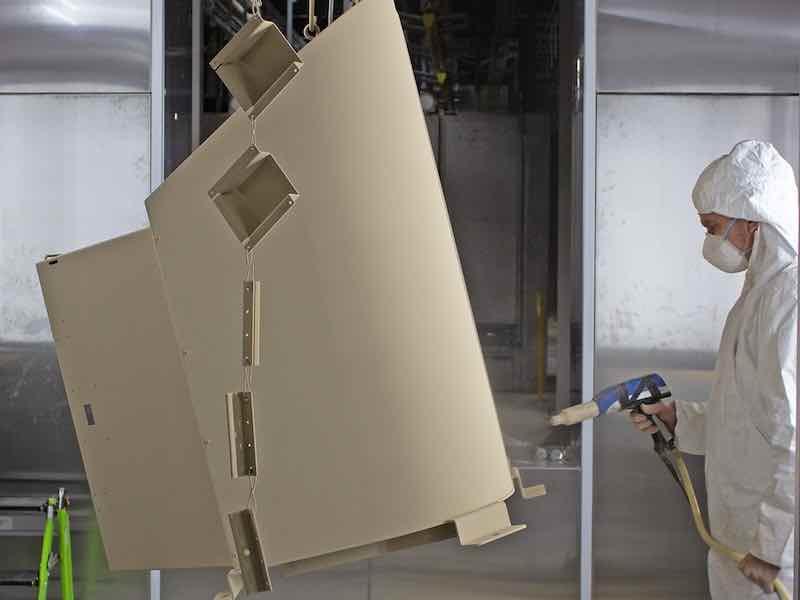 The modular design of the system allows for easy customization and quick installation.The addition of an upgraded powder coating system has been on R.J. Thomas Manufacturing’s to-do list for some time, and especially since business has been growing for the last several years.
The modular design of the system allows for easy customization and quick installation.The addition of an upgraded powder coating system has been on R.J. Thomas Manufacturing’s to-do list for some time, and especially since business has been growing for the last several years.
The company has been designing and manufacturing the Pilot Rock brand of park, street, and campsite equipment since its inception. The outdoor park equipment includes campfire rings, grills, benches, picnic tables, and trash receptacles, which are used in parks, campgrounds, or someone’s backyard.
R.J. Thomas Manufacturing’s fabrication services include product design, material sourcing, fiber laser cutting, deburring, CNC sheet metal forming, rod forming, CNC tube bending, manual and robotic welding, as well as powder and thermoplastic coatings.
And like most companies that coat after fabrication, the powder coating operation often struggled to keep pace with the ever-increasing production schedules. That was one reason that Thomas and other members of the company’s management team had been looking at upgrading the coating equipment for several years.
“The current system is a loop that splits into two lanes at the cure process. They have a way to add an inner loop to the system that will allow them to add a prime booth and a prime oven, and unite the two main systems if they want to do a single system in the future.”
“Powder and thermal coating has always been our bottleneck,” Thomas says. “In this case, we wanted a system that could speed up those processes, and we wanted to be able to combine those two processes. We wanted something that would maintain the quality that we've always had — if not improve it — and I think this system checked all those boxes, and that's why we pulled the trigger.”
R.J. Thomas Manufacturing pulled the trigger with Intellifinishing, a full-service provider of finishing systems. The company is a subsidiary of Kasa Controls & Automation, which provides turnkey industrial controls and automation engineering expertise to a variety of manufacturers in the grain handling, automotive, food processing, baggage handling, and heavy/industrial equipment industries. They also build custom UL control panels for companies such as General Motors, Ford, Sara Lee, and Philips.
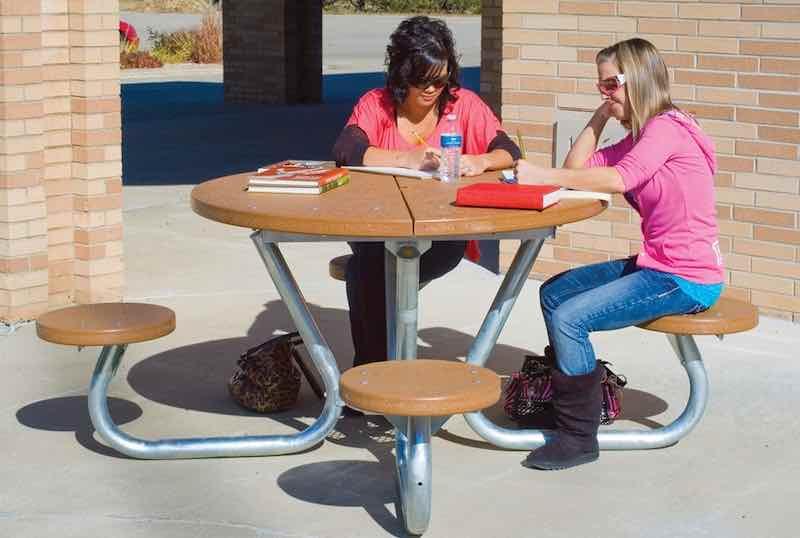 The Cherokee, Iowa, manufacturer makes Pilot Rock park equipment, and was founded in 1959.
The Cherokee, Iowa, manufacturer makes Pilot Rock park equipment, and was founded in 1959.
Using Friction-Driven Conveyors and Smart Controls
Intellifinishing usually partners with Midwest Finishing Systems and Intellitrak on its finishing system for custom coaters and various industries, and the R.J. Thomas Manufacturing project was no different.
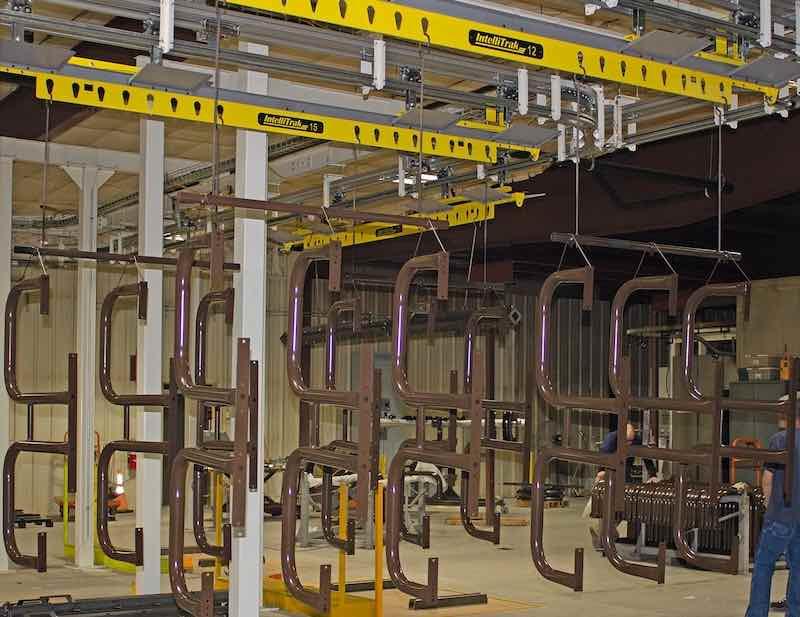 RJ Thomas' team liked IntelliFinishing’s unique powder coating and liquid paint finishing equipment that uses friction-driven conveyors and smart controls to optimize production efficiency.What caught the eye of Thomas and the company’s management team was IntelliFinishing’s unique powder coating and liquid paint finishing equipment that uses friction-driven conveyors and smart controls to optimize production efficiency.
RJ Thomas' team liked IntelliFinishing’s unique powder coating and liquid paint finishing equipment that uses friction-driven conveyors and smart controls to optimize production efficiency.What caught the eye of Thomas and the company’s management team was IntelliFinishing’s unique powder coating and liquid paint finishing equipment that uses friction-driven conveyors and smart controls to optimize production efficiency.
The modular design of the system allows for easy customization and quick installation. It allows for adapting to the customer’s various part sizes and process requirements, which was especially the case for R.J. Thomas Manufacturing.
The company added a new building to accommodate the Intellifinishing system, which was an advantage for ease of design and installation, according to John Claman, Sales Representative and Marketing Supervisor for Intellifinishing.
They began working with R.J. Thomas Manufacturing in early 2024. They began sketching the basic plan for the system, which included planning for growth and ensuring the system’s flexibility to take on that additional work in the future.
 John Claman“The current system is a loop that splits into two lanes at the cure process,” Claman says. “It is a 4-stage wash, a dry-off oven, one topcoat booth, two cure ovens on parallel tracks, and then back to unload. But they have a way to add an inner loop to the system that will allow them to add a prime booth and a prime oven, which they haven't done yet. They also have a way to add a loop to the booth on the outside edge, which will serve as their thermal coat option. They will be able to unite the two main systems if they want to do a single system in the future.”
John Claman“The current system is a loop that splits into two lanes at the cure process,” Claman says. “It is a 4-stage wash, a dry-off oven, one topcoat booth, two cure ovens on parallel tracks, and then back to unload. But they have a way to add an inner loop to the system that will allow them to add a prime booth and a prime oven, which they haven't done yet. They also have a way to add a loop to the booth on the outside edge, which will serve as their thermal coat option. They will be able to unite the two main systems if they want to do a single system in the future.”
Customization and Adaptability to Handle Various Part Sizes and Shapes
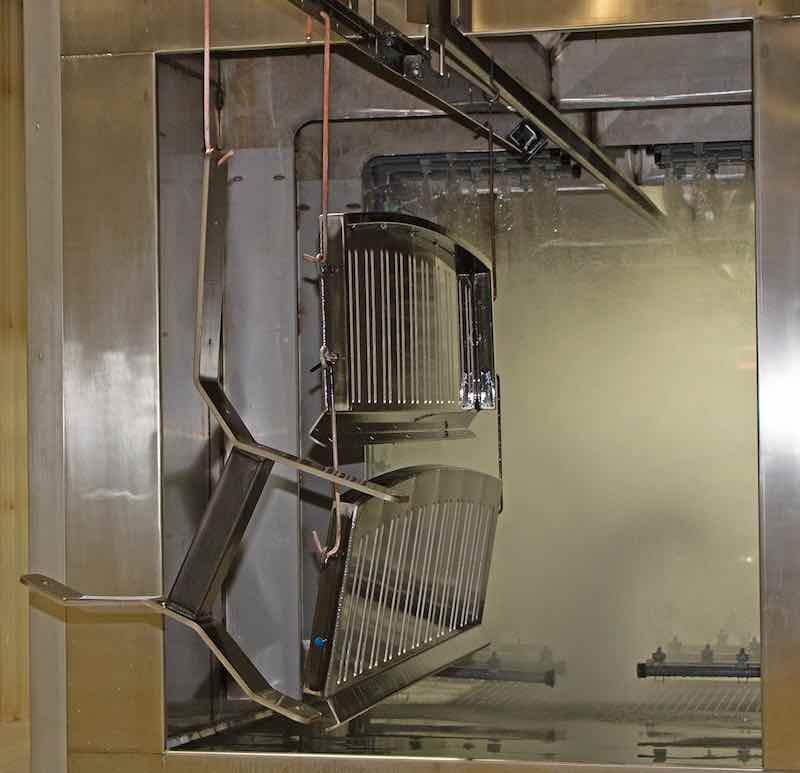 The system has a 4-stage wash, a dry-off oven, one topcoat booth, two cure ovens on parallel tracks, and then back to unload.IntelliFinishing’s recipe-based smart controls offer customization and adaptability to handle various part sizes and shapes. Claman says the system’s ability to move carriers in multiple directions — along with shuttles, lifts, and deadheads — reduces space requirements and enhances efficiency.
The system has a 4-stage wash, a dry-off oven, one topcoat booth, two cure ovens on parallel tracks, and then back to unload.IntelliFinishing’s recipe-based smart controls offer customization and adaptability to handle various part sizes and shapes. Claman says the system’s ability to move carriers in multiple directions — along with shuttles, lifts, and deadheads — reduces space requirements and enhances efficiency.
“The smart control system is definitely one of our distinctive advantages, but it's also a byproduct of how the conveyor works,” Claman says. “ It works with the friction tube conveyor, and for the 500 series conveyor each section of track has a half-horsepower motor and belts that drive the trolley forward or backward.”
Because there are a lot of motors around the track, the control system ensures things don’t run into other things.
“We have a control system that can account for what every motor is doing,” Claman says. “And we know where every carrier is at any given time.”
The advantages to the system, he says, are the ability to unite the washes and the ovens, which were built and installed by their partner, Midwest Finishing Systems. They are integrated so that they can give a recipe approach for each carrier.
“We train them on the operations, such as the load station and the unload station, as well as the main interactions maintaining the wash and chemistry.”
For example, the wash pressure can be varied if lightweight parts are being hung; the less pressure will help to keep those from flying off the line, Claman says. That information is integrated with the motor systems to allow a recipe approach for each carrier.
“ I don't think that they probably vary the wash much, but they may vary the cure and the dry off times per carrier,” he says of R.J. Thomas Manufacturing. “For example, if they have some products that tend to retain humidity and moisture, they can vary the dry time, and of course they would vary the cure time based on bring-up time, too.”
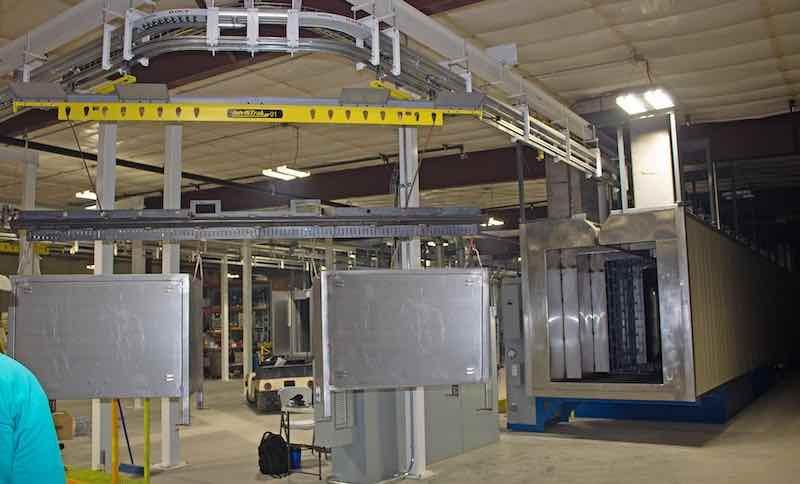 The system was an upgrade for R.J. Thomas Manufacturing over its monorail system.
The system was an upgrade for R.J. Thomas Manufacturing over its monorail system.
Improvements Are a Big Upgrade to Monorail System
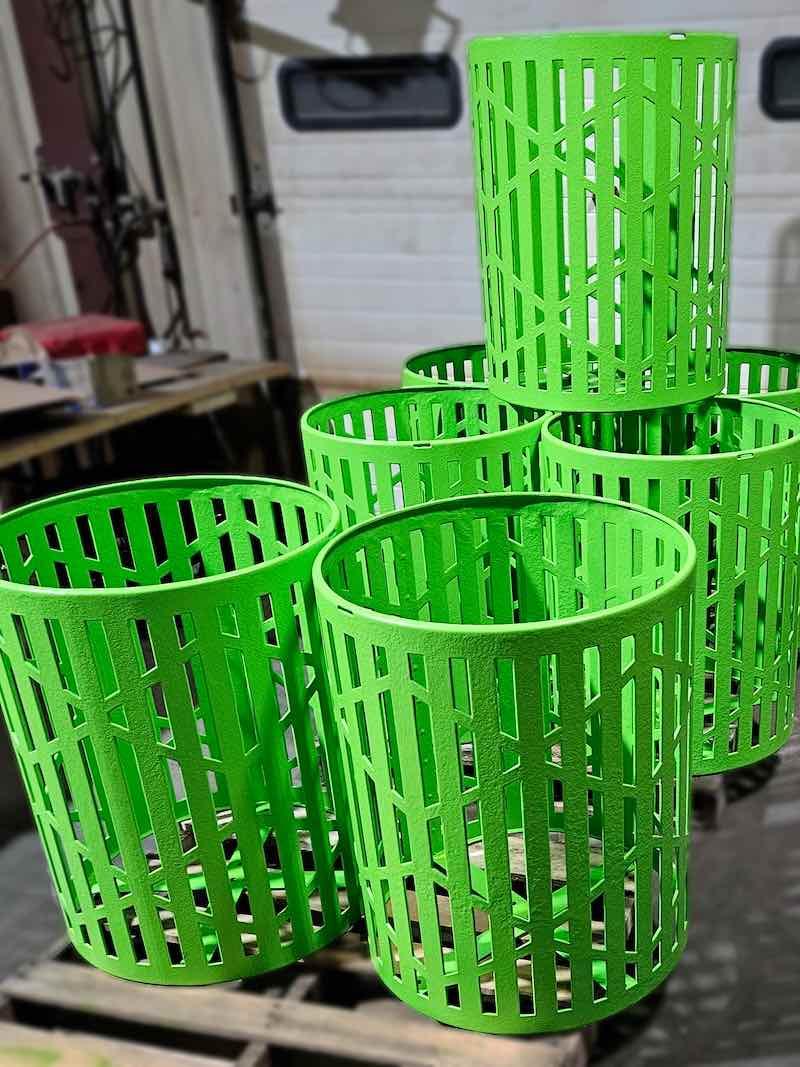 Powder coated trash cans await shopping to a park service.The improvements were a big upgrade for R.J. Thomas Manufacturing, which had a monorail system previously and very little control over the processes.
Powder coated trash cans await shopping to a park service.The improvements were a big upgrade for R.J. Thomas Manufacturing, which had a monorail system previously and very little control over the processes.
“Monorails have essentially no real control system,” Claman says. “They might have the ability on a panel to speed it up a little bit or slow it down. But other than that, it’s all you get. And when you do that, you speed up every item on the line or slow it down.”
Of course, with a new system and all the bells and whistles come the need for properly training a staff to use it, and Heath Roker, a Senior Project Manager for Intellifinishing, says they spent some time bringing the R.J. Thomas Manufacturing team up to speed on how to utilize the controls and manage the recipes.
“We train them on the operations, such as the load station and the unload station, as well as the main interactions maintaining the wash and chemistry,” Roker says. “Midwest Finishing System trains them on that, but most of the interactions just at the load and unload since the recipe is set and travels with each carrier.”
Roker adds that the system tracks the data through stations, such as the wash chemistry associated with a carrier going through the wash system. The system also tracks the oven temperatures for the zones it passes through to identify any potential quality issues; if there are, the system allows operators to review the specific data.
“It's mainly about loading parts and setting up,” Roker says. “It’s simple enough to run that it's fairly easy to train on. There are not a lot of complicated uptakes; most production workers pick it up pretty quickly.”
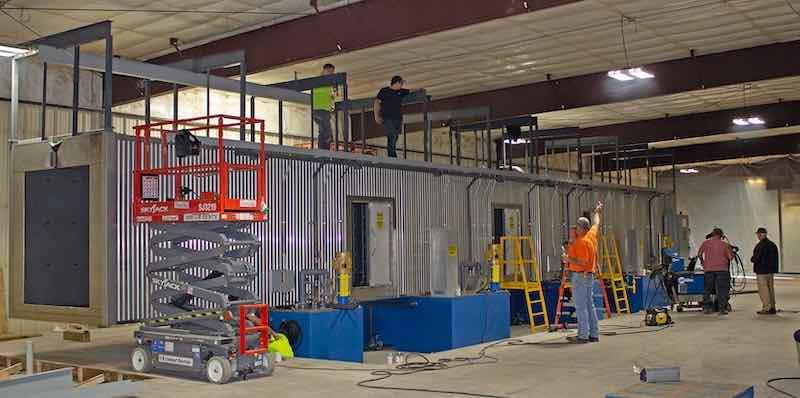 Intellifinishing partnered with Midwest Finishing Systems on the installation.
Intellifinishing partnered with Midwest Finishing Systems on the installation.
History Built on Agricultural Innovations
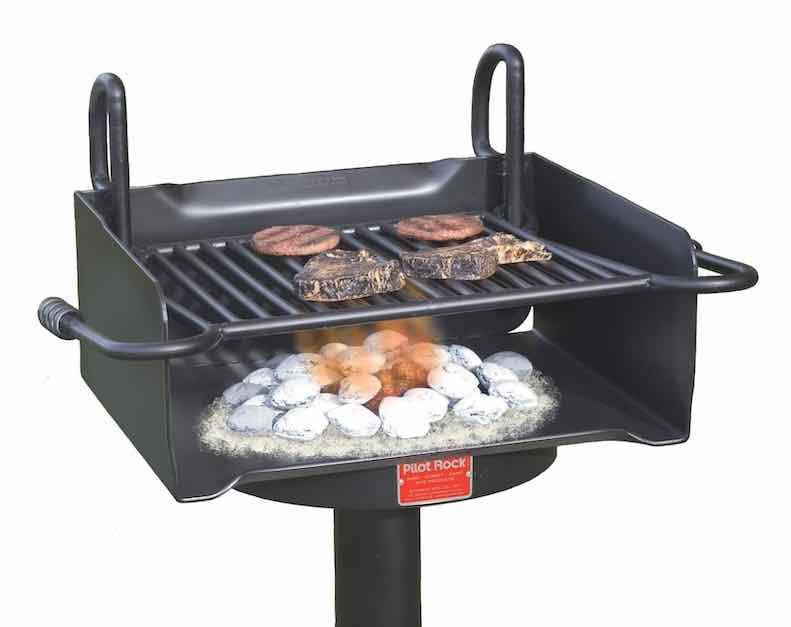 R.J. Thomas Manufacturing’s fabrication services include product design, material sourcing, fiber laser cutting, deburring, CNC sheet metal forming, rod forming, CNC tube bending, manual and robotic welding.And for R.J. Thomas Manufacturing, simplicity is a way of life at the company founded by R.J. and Doris Thomas in 1959. R.J. worked in the design department of John Deere in Waterloo, Iowa, where he helped design tractors and other equipment. After serving in the U.S. Navy, he returned to Iowa. He opened his own fabrication business where he made and sold his invention called the Pulver Rooter with counter-rotating knives, which simultaneously cultivated and plowed corn and cotton fields.
R.J. Thomas Manufacturing’s fabrication services include product design, material sourcing, fiber laser cutting, deburring, CNC sheet metal forming, rod forming, CNC tube bending, manual and robotic welding.And for R.J. Thomas Manufacturing, simplicity is a way of life at the company founded by R.J. and Doris Thomas in 1959. R.J. worked in the design department of John Deere in Waterloo, Iowa, where he helped design tractors and other equipment. After serving in the U.S. Navy, he returned to Iowa. He opened his own fabrication business where he made and sold his invention called the Pulver Rooter with counter-rotating knives, which simultaneously cultivated and plowed corn and cotton fields.
R.J. later developed an insecticide bander, which proved very popular. But custom design work eventually led the company into the park equipment business. In the 1960s, R.J. Thomas Manufacturing was approached about designing and building grills for a new park system in the area; soon, they were manufacturing picnic tables and benches for the parks.
The business has grown to where they now offer park charcoal grills, campfire rings, benches, picnic tables, picnic table frame kits, dog park equipment, pet waste bag stations, trash and recycling receptacles, and more for parks and campgrounds. They also manufacture equipment for streetscapes and landscapes, athletic and recreational facilities, schools and colleges, businesses, and individuals.
The R.J. Thomas Manufacturing physical facilities of the company have been expanded and enlarged 10 times since 1980, plus two major expansions and upgrades of the office facilities. The latest 30,000 sq. ft. factory expansion was completed in 2019, and is over six times larger than R.J.’s original building.
New Powder Coating Operation Planned for Growth
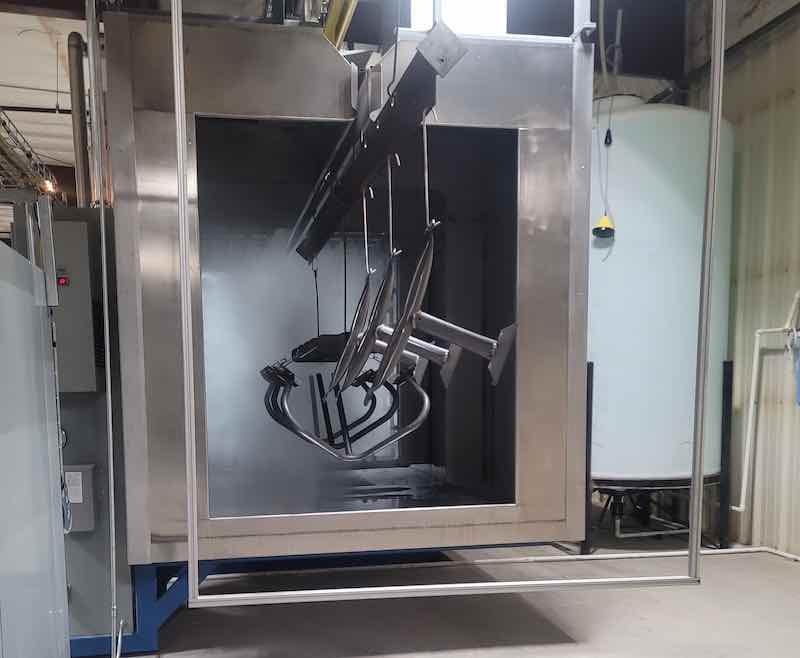 That is why Adam Thomas says it was important for the new powder coating operation to be planned with growth in mind.
That is why Adam Thomas says it was important for the new powder coating operation to be planned with growth in mind.
“ John and Heath worked with their team to come up with a drawing that I think worked for everybody,” Thomas says. “They planned for the additions of the thermocoat system to the system, and we can add more powder booths and add a primer booth.”
Having the ability to add an unlimited number of recipes for the various parts that need coating has also been a huge plus for the R.J. Thomas Manufacturing operation.
“We can change the recipe for every different part that goes through there,” Thomas says. “If we have got some parts that require a lot more time in the wash — or require different temperatures — it can provide a more thorough rinse. That's been a great ability to have.”
If parts are to be thermocoated — dipped into a powder coating bed to be coated instead of hung — the system is smart enough to skip a whole section of the line and go straight from the wash and the dry to the thermalcoat area.
“Any parts that are powdered, they go from the wash to dry to powder coat, and then we've got a two-lane oven,” Thomas says. “If you have parts that take a lot more time to dry, those can move into a slow lane, and everything else can just breeze right on by them. That has really sped up our production, and we get a lot more parts through the system in a day, and it takes fewer people to do it.”
Data Collection is a Big Part of the New Powder Coating System
 The data collection of the new powder coating system is another feature that R.J. Thomas Manufacturing did not have before, and they plan to use it to study their efficiency and, more importantly, how they can become even more efficient.
The data collection of the new powder coating system is another feature that R.J. Thomas Manufacturing did not have before, and they plan to use it to study their efficiency and, more importantly, how they can become even more efficient.
“We are working on a new ERP system right now,” Thomas says. “We've always got multiple huge projects going on at the same time, and so with our new ERP system, we're planning to be able to track inventory parts better, and be able to see where they're at in the system.”
The goal, Thomas says, is that when a customer calls about an order, the customer service team doesn't need to call out to the plant. Instead, he says they can look in the system and see when parts are being coated.
“They should be able to tell them they will ship out within the next day or so,” he says.
Thomas says the new powder coating system is giving the company peace of mind that its finishing system is working just as the other parts of the manufacturing process are.
“Definitely the problem with powder coating was you don't know until a year or two down the road if you've got a problem,” he says. “And if you do, it’s going to be a major problem, because everything that you've coated in the last year probably has that same problem. As best you can, you have to make sure everything is foolproof, and this system helps us get closer to that.”
Visit https://www.pilotrock.com and https://www.rjthomasfabrication.com. Visit https://intellifinishing.com.




